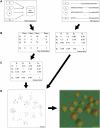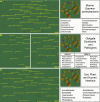Predicting prokaryotic ecological niches using genome sequence analysis
- PMID: 17710143
- PMCID: PMC1937020
- DOI: 10.1371/journal.pone.0000743
Predicting prokaryotic ecological niches using genome sequence analysis
Abstract
Automated DNA sequencing technology is so rapid that analysis has become the rate-limiting step. Hundreds of prokaryotic genome sequences are publicly available, with new genomes uploaded at the rate of approximately 20 per month. As a result, this growing body of genome sequences will include microorganisms not previously identified, isolated, or observed. We hypothesize that evolutionary pressure exerted by an ecological niche selects for a similar genetic repertoire in those prokaryotes that occupy the same niche, and that this is due to both vertical and horizontal transmission. To test this, we have developed a novel method to classify prokaryotes, by calculating their Pfam protein domain distributions and clustering them with all other sequenced prokaryotic species. Clusters of organisms are visualized in two dimensions as 'mountains' on a topological map. When compared to a phylogenetic map constructed using 16S rRNA, this map more accurately clusters prokaryotes according to functional and environmental attributes. We demonstrate the ability of this map, which we term a "niche map", to cluster according to ecological niche both quantitatively and qualitatively, and propose that this method be used to associate uncharacterized prokaryotes with their ecological niche as a means of predicting their functional role directly from their genome sequence.
Conflict of interest statement
Figures





Similar articles
-
The phylogenetic and ecological context of cultured and whole genome-sequenced planktonic bacteria from the coastal NW Mediterranean Sea.Syst Appl Microbiol. 2014 May;37(3):216-28. doi: 10.1016/j.syapm.2013.11.005. Epub 2014 Jan 23. Syst Appl Microbiol. 2014. PMID: 24462268
-
Ecosystem-wide metagenomic binning enables prediction of ecological niches from genomes.Commun Biol. 2020 Mar 13;3(1):119. doi: 10.1038/s42003-020-0856-x. Commun Biol. 2020. PMID: 32170201 Free PMC article.
-
RibAlign: a software tool and database for eubacterial phylogeny based on concatenated ribosomal protein subunits.BMC Bioinformatics. 2006 Feb 13;7:66. doi: 10.1186/1471-2105-7-66. BMC Bioinformatics. 2006. PMID: 16476165 Free PMC article.
-
[Copy number of ribosomal operons in prokaryotes and its effect on phylogenic analyses].Mikrobiologiia. 2003 Jul-Aug;72(4):437-52. Mikrobiologiia. 2003. PMID: 14526531 Review. Russian.
-
Microbial ecology in the age of genomics and metagenomics: concepts, tools, and recent advances.Mol Ecol. 2006 Jun;15(7):1713-31. doi: 10.1111/j.1365-294X.2006.02882.x. Mol Ecol. 2006. PMID: 16689892 Review.
Cited by
-
A flood of microbial genomes-do we need more?PLoS One. 2009 Jun 9;4(6):e5831. doi: 10.1371/journal.pone.0005831. PLoS One. 2009. PMID: 19513110 Free PMC article. No abstract available.
-
Genomics of the Pathogenic Clostridia.Microbiol Spectr. 2019 May;7(3):10.1128/microbiolspec.gpp3-0033-2018. doi: 10.1128/microbiolspec.GPP3-0033-2018. Microbiol Spectr. 2019. PMID: 31215504 Free PMC article. Review.
-
A bacterial sensor taxonomy across earth ecosystems for machine learning applications.mSystems. 2024 Jan 23;9(1):e0002623. doi: 10.1128/msystems.00026-23. Epub 2023 Dec 11. mSystems. 2024. PMID: 38078749 Free PMC article.
-
Presence and diversity of Streptomyces in Dendroctonus and sympatric bark beetle galleries across North America.Microb Ecol. 2011 May;61(4):759-68. doi: 10.1007/s00248-010-9797-0. Epub 2011 Jan 20. Microb Ecol. 2011. PMID: 21249352
-
Towards an Understanding of Large-Scale Biodiversity Patterns on Land and in the Sea.Biology (Basel). 2023 Feb 21;12(3):339. doi: 10.3390/biology12030339. Biology (Basel). 2023. PMID: 36979031 Free PMC article. Review.
References
-
- Riesenfeld CS, Schloss PD, Handelsman J. Metagenomics: genomic analysis of microbial communities. Annu Rev Genet. 2004;38:525–552. - PubMed
-
- Cohan FM. Concepts of bacterial biodiversity for the age of genomics. In: Fraser CM, Read T, Nelson KE, editors. Microbial Genomes. Totowa, NJ: Humana Press; 2004.
-
- Goldenfeld N, Woese C. Biology's next revolution. Nature. 2007;445:369. - PubMed
-
- Martiny JB, Field D. Ecological perspectives on the sequenced genome collection. Ecology Letters. 2005;8:1334–1345.
MeSH terms
Substances
LinkOut - more resources
Full Text Sources
Research Materials

